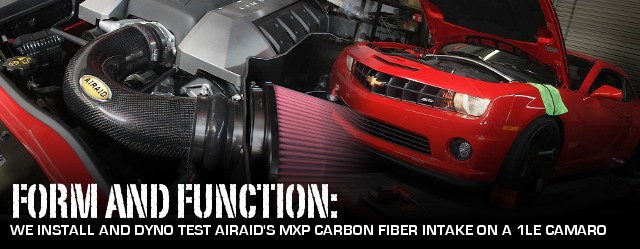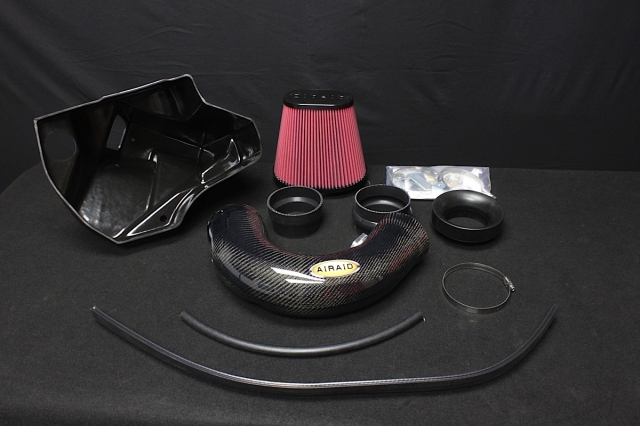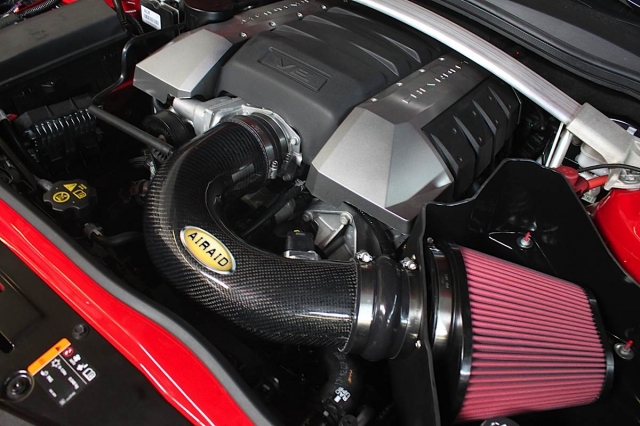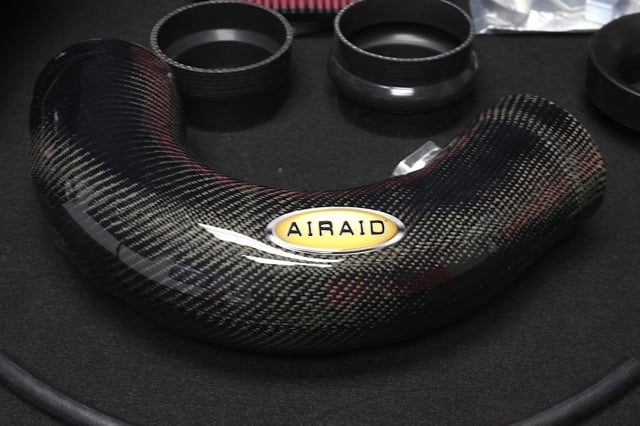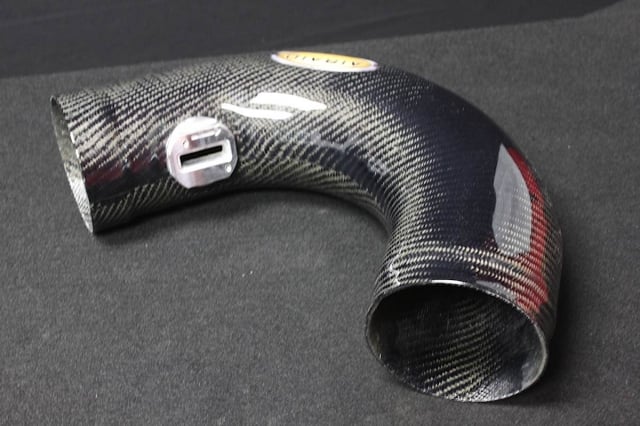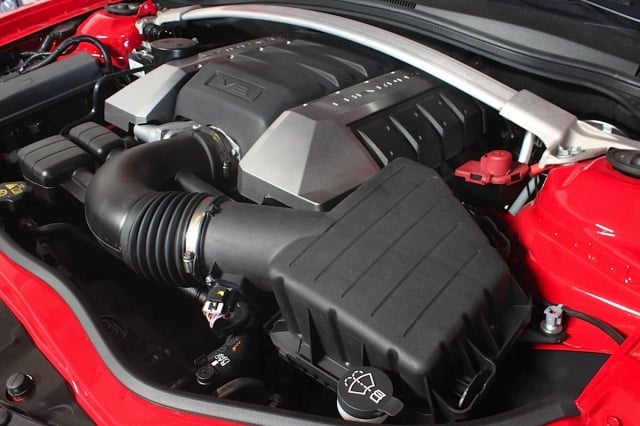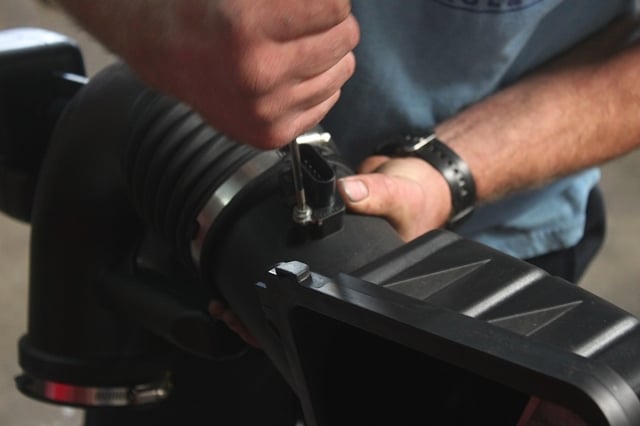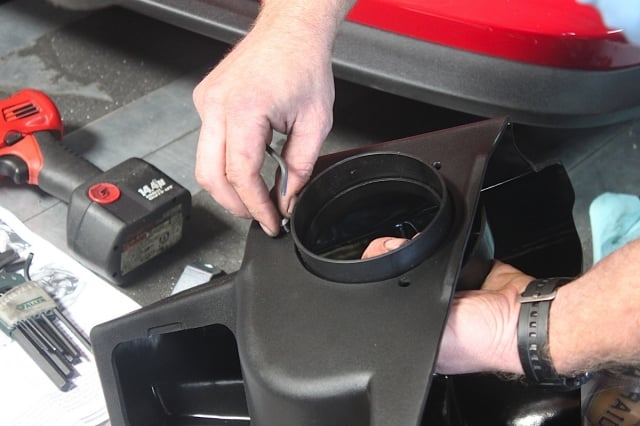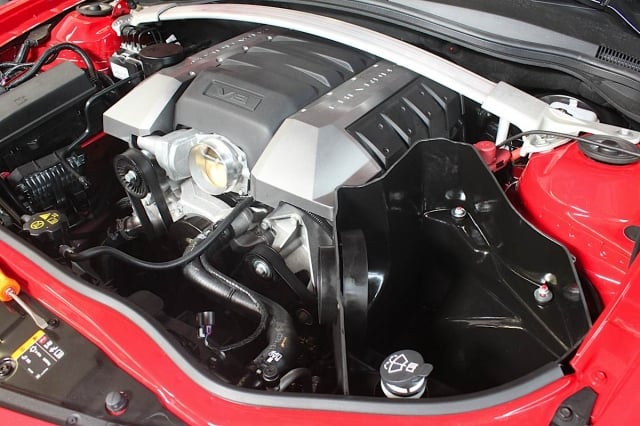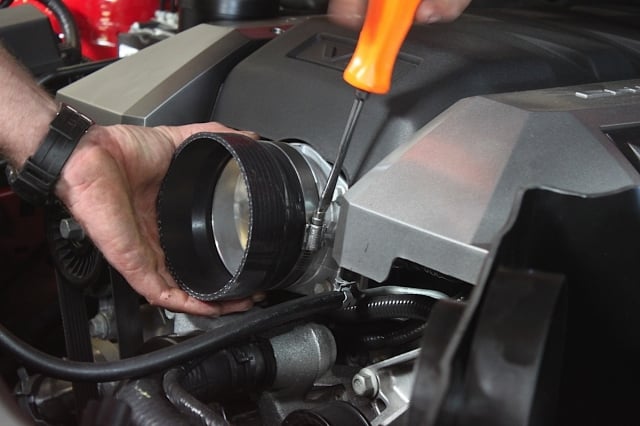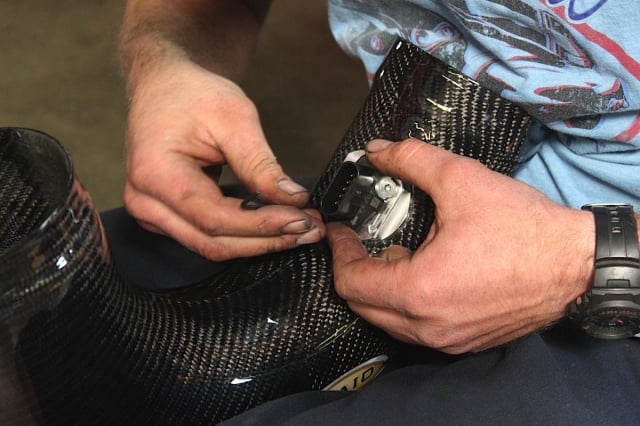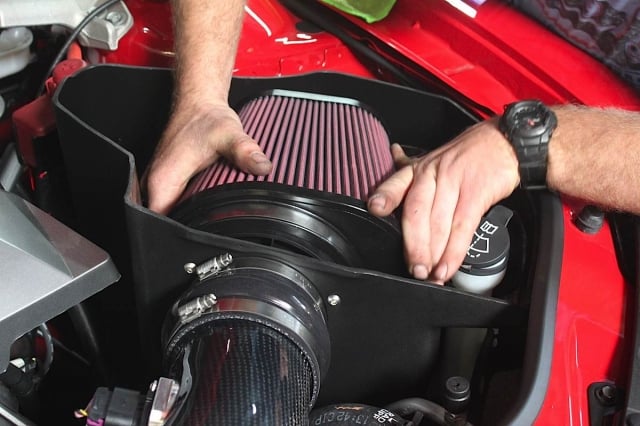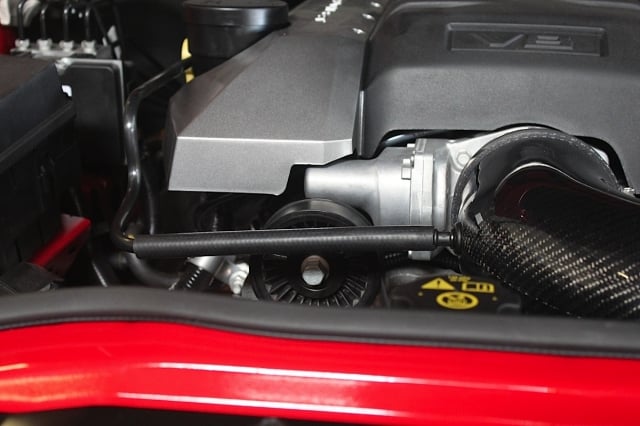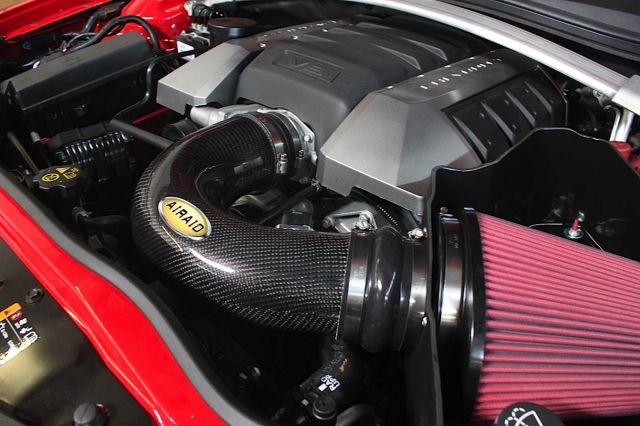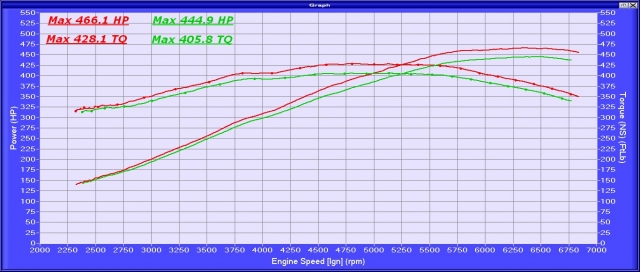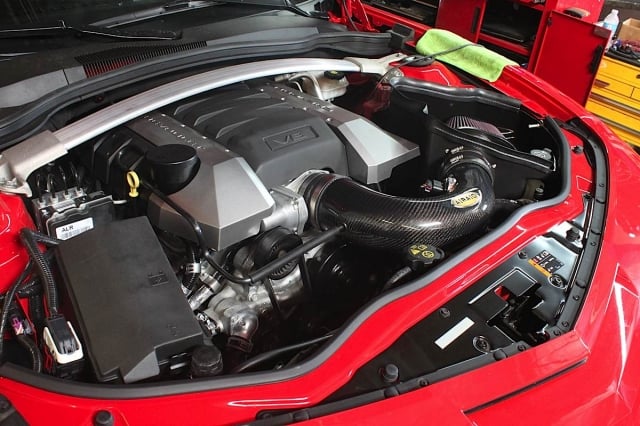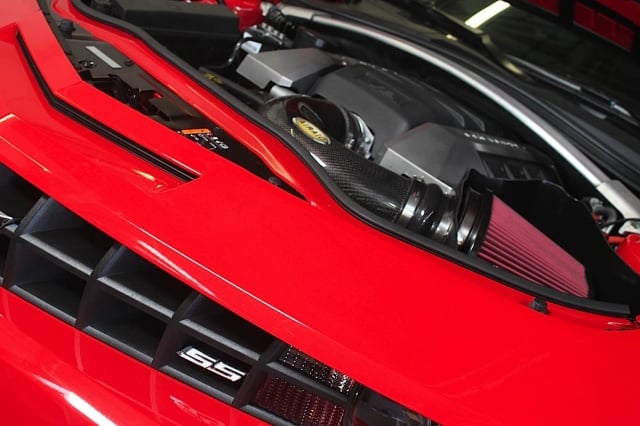It’s 100-percent real hand-laid carbon fiber – nothing fake about it. – Trenton McGee, Airaid
Personally, we’ll take function over form in our speed parts any day of the week. On the other hand, we’ll also be the first to admit that the very best performance parts are those that seamlessly combine the two elements – parts that look just as awesome as they perform.
The MXP carbon fiber series cold air intakes from Airaid definitely fit that bill, and we have wanted to get our hands on one of these bad boys since they were first released a little over a year ago. Needless to say, we jumped at the chance to install one for ourselves on a 5th Gen Camaro, and do a little independent dyno testing while we were at it.
The Ammunition: Airaid’s MXP Real Carbon Fiber Intake System
Airaid offers several levels of intakes for the 5th Gen Camaro from just a replacement intake tube to full cold air systems, and the MXP series are the flagship of their lineup. The MXP series intakes feature a roto-molded cold air box that keeps the oversized high-flow 1,400 CFM air filter separated from the high temperatures of the engine bay. The particular model we tested was part number 251-243C, which stands out from the crowd with its trick 4.5-inch diameter carbon fiber intake tube.
“It’s 100-percent real hand-laid carbon fiber – nothing fake about it,” says Airaid’s Trenton McGee. The intake tubes on the standard MXP line are made of polyethylene, which is a high density plastic that is the same type many of the OEs use. It’s a great high-quality material, but it the carbon fiber goes a long way in adding that extra visual pop to the engine compartment.
“There is a minimal weight savings with the carbon fiber versus the polyethylene, though it’s a matter of ounces,” says McGee. “The real advantage of the carbon fiber construction is the aesthetics. It’s for anyone wanting to add a show-quality finish to their vehicle, and the best of the best. Beyond that, the function is the exact same as the original MXP intake system and is designed to optimize air flow into the engine and eliminate any restrictions or design shortcomings in the factory intake.”
This particular intake also comes with Airaid’s Syntha-Max high-flow air filter. McGee tells us, “The Syntha-Max uses our proprietary synthetic material, and the essential advantage to it is that you never have to oil it. When it’s ready to be cleaned, you just take it off the car and hose it down with Simple Green, Formula 409, or any other non-petroleum based cleaner. Let it sit for a while, thoroughly rinse it from the inside out, and let it dry naturally without using any kind of compressed air. When it’s dry, just stick it back on the car and go.” The carbon fiber intake tube is truly a thing of beauty. Note the billet adapter for the stock MAF sensor.
So how do these non-oiled filters perform compared to the oiled ones we’re all familiar with? “The oiled Syntha-Flow and the non-oiled Syntha-Max have the exact same filtration capabilities, and flow nearly the same,” says McGee. “To get the Syntha-Max’s filtration where we needed it to be, we had to make the orifices just a little bit smaller, but the flow is easily within 5-percent of the Syntha-Flow.” We also learned that these slightly smaller openings also mean that the Syntha-Max filter will need cleaned a little more often, but it’s a difference of a 30,000 to 35,000 mile service interval with the oiled filter versus 25,000 miles with the non-oiled Syntha-Max.
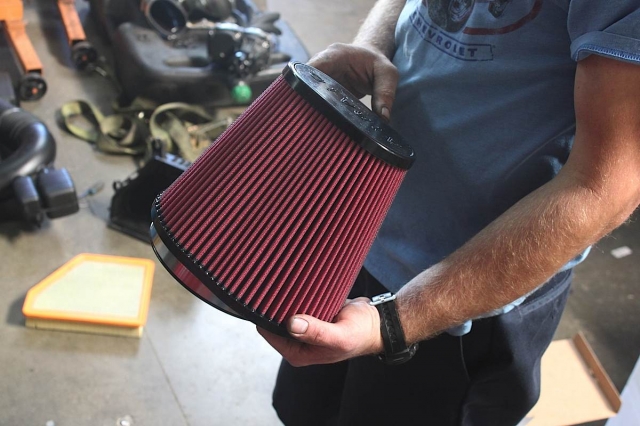
The massive air filter that came with our MXP intake is one of Airaid’s Syntha-Max reusable units that never needs to be oiled.
All of our intake systems are bolt in and go. We specifically design them so that no tuning is necessary or required.
One of the unique things about Airaid’s MXP series intakes is that they aren’t supposed to require any type of tuning after installation. “All of our intake systems are bolt in and go. We specifically design them so that no tuning is necessary or required,” McGee tells us. So, how exactly do Airaid’s engineers accomplish that? Testing – lots and lots of testing.
McGee says, “We start with the stock intake system on our in-house flow bench, and we find out exactly where the restrictions are in the factory design. We then use computer modeling to optimize our system to eliminate all those restrictions, but in a way that will keep things within the parameters the factory MAF sensor is looking for. This way we can improve the airflow without adversely affecting the air-fuel ratios.”
It should be noted that the gearhead looking for the absolute most out of his car will still want to consider a professional tune. Factory tunes are typically extremely conservative, and there are some definite gains to be had even if there were no other changes made to the car. Of course, the MXP intake system will help get even more out of a tune.
The Weapon: Ryne Cunningham’s 2013 Camaro 1LE
To test the Airaid carbon fiber MXP cold air intake, we enlisted the help of our buddies at Cunningham Motorsports (CMS) in Murrieta, California. They just so happen to have access to a fresh 2013 Camaro 1LE that belongs to owner Ryne Cunningham – a perfect test-bed for the carbon fiber MXP cold air intake.
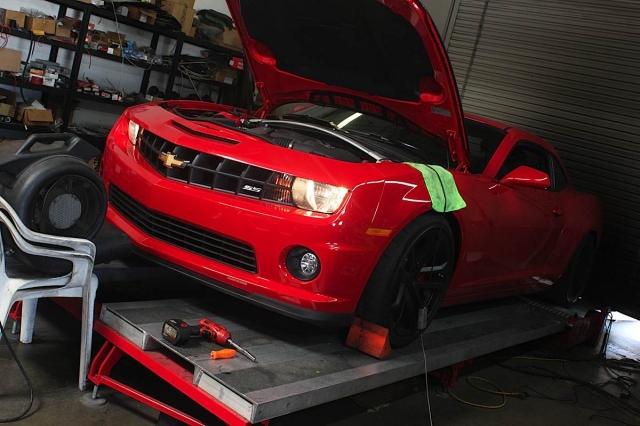
Ryne Cunningham from CMS was kind enough to let us use his modified 1LE Camaro for our install and dyno test.
As you would expect from any gearhead who owns both his own shop and a hot new performance car, the 1LE already has a pretty impressive list of modifications. For starters, the LS3 has been outfitted with a CMS custom cam of undisclosed grind specifications that is set up especially for road racing. A set of long-tubes from American Racing Headers, the 1LE’s stock NPP dual mode exhaust system, and a CMS custom tune round out the power mods. The suspension has been further upgraded with sway bars, rear cradle bushings, and higher-rate lowering springs from Pfadt Race Engineering.
CMS put the 1LE up on CMS’s Dyno Dynamics dynamometer for our baseline, and the modified LS3 fired out 444.9 horsepower and 405.8 pound-feet of torque at the rear wheels.
Locking and Loading: Installing the Carbon MXP Intake
The removal of the stock intake was a snap, and it can be easy to forget that you need to pull a few parts off for later like the MAF sensor.
The air filter adapter is bolted to the cold air box, which bolts into the stock air box's location.
CMS installed the stock MAF sensor on the carbon intake tube and slid it into the couplers. Easy as pie...
The last step is to pop in the air filter and cut the new breather hose to length.
Ready. Aim. FIRE! – The Final Dyno Results
Since Airaid sells the carbon fiber MXP as a no-tune cold air intake, that is exactly how we ran it to get our final dyno numbers with the 1LE – it was a straight parts swap with no other changes. As we mentioned before, the car never even came off the dyno.
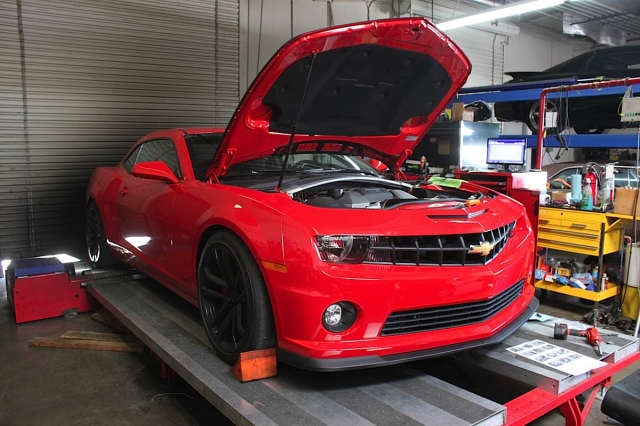
It turns out the carbon fiber MXP intake wasn’t just for good looks – it can make some pretty good power too…
We were very impressed with results; 466.1 horsepower and 428.1 pound-feet of torque at the rear wheels. That’s a total gain of 21.2 horsepower and 22.3 pound-feet of torque over our baseline numbers just from adding the MXP cold air intake. The air-fuel ratios were essentially unchanged from our baseline test, and seemed to validate Airaid’s no-tune claims.
As you can see from the dyno graph, the Airaid MXP out-paces the stock intake throughout the entire RPM range, and the MXP starts to show real torque gains as low as 2,900 RPM. However, as you might expect, the extra air volume and velocity really pays the highest dividends in both horsepower and torque from 4,000 RPM up to the redline.
Dyno Test Results With Airaid MXP Carbon Fiber Intake
- Before: 444.9 HP and 405.8 TQ
- After: 466.1 HP and 428.1 TQ
- Gain: 21.2 HP and 22.3 TQ
The Final Gear…
We found the carbon fiber MXP cold air intake to be a perfect blend of form and function. Not only did it make great power even without a tune, but the look, fit, and finish of the entire system is absolutely superb. It’s clear that Airaid spent a lot of time designing this system specifically for the 5th Gen Camaro, and didn’t make any compromises. Great fit, high quality finishes, and great power - talk about getting both form and function from the same performance part.



